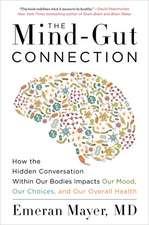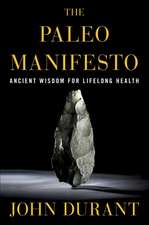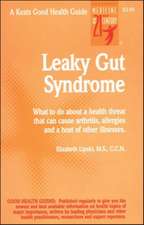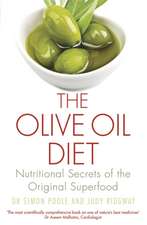The Metabolic Typing Diet
Autor William Linz Wolcotten Limba Engleză Paperback – 4 sep 2002
For hereditary reasons, your metabolism is unique. Cutting-edge research shows that no single diet works well for everyone–the very same foods that keep your best friend slim may keep you overweight and feeling unhealthy and fatigued. Now, William Wolcott, a pioneer in the field of metabolic research, has developed a revolutionary weight-loss program that allows you to identify your "metabolic type" and create a diet that suits your individual nutritional needs.
In The Metabolic Typing Diet, Wolcott and acclaimed science writer Trish Fahey provide simple self-tests that you can use to discover your own metabolic type and determine what kind of diet will work best for you. It might be a low-fat, high carbohydrate diet filled with pasta and grains, or a high-fat, high-protein diet focused on meat and seafood, or anything in between. By detailing exactly which foods and food combinations are right for you, The Metabolic Typing Diet at last reveals the secret to shedding unwanted pounds and achieving optimum vitality with lasting results.
The Metabolic Typing Diet will enable you to:
Achieve and maintain your ideal weight
Eliminate sugar cravings
Enjoy sustained energy and endurance
Conquer indigestion, fatigue, and allergies
Bolster your immune system
Overcome anxiety, depression, and mood swings
Preț: 90.39 lei
Preț vechi: 107.87 lei
-16% Nou
Puncte Express: 136
Preț estimativ în valută:
17.30€ • 18.06$ • 14.31£
17.30€ • 18.06$ • 14.31£
Carte disponibilă
Livrare economică 15-22 martie
Livrare express 01-07 martie pentru 42.42 lei
Preluare comenzi: 021 569.72.76
Specificații
ISBN-13: 9780767905640
ISBN-10: 0767905644
Pagini: 448
Ilustrații: illustrations
Dimensiuni: 135 x 204 x 25 mm
Greutate: 0.36 kg
Ediția:New ed.
Editura: HARMONY
Locul publicării:United States
ISBN-10: 0767905644
Pagini: 448
Ilustrații: illustrations
Dimensiuni: 135 x 204 x 25 mm
Greutate: 0.36 kg
Ediția:New ed.
Editura: HARMONY
Locul publicării:United States
Notă biografică
William Wolcott is widely regarded as the world’s leading authority on metabolic typing and has played a central role in advancing this unique dietary science. He is the founder of Healthexcel, an organization that provides technical consulting services to health professionals. Trish Fahey is a consumer expert in the area of metabolic typing and a health and science writer who specializes in the field of alternative medicine.
Extras
Chapter 1
One Man's Food Is Another's Poison
The Wisdom of Ancestral Diets
Would you believe that in certain remote regions of the world there are old and indigenous cultures in which our modern epidemics--obesity, heart disease, cancer, diabetes, colitis, hypertension, arthritis, and the like--are virtually unknown?
For many years scientists have observed isolated cultures in which people maintain levels of health and fitness that are vastly superior to the health status of those of us who live in modern societies.
Yet these remarkably strong people live in primitive environments very far removed from the industrial mainstream, where there are none of the vast resources so widely available in "advanced" civilizations--no high-tech medicine, no scientists or clinicians or academic institutions, no multibillion-dollar research programs, no health officials or government advisory boards, no vitamin industry, fitness clubs, health spas, weight loss clinics, or health-oriented media.
Oddly enough, the native diets of these old and indigenous cultures are far from what you and I might consider healthful.
Imagine: Traditional Alaskan Eskimos with excellent immunity and cardiovascular health thriving on large quantities of fat and several pounds of meat a day. Daily diets centered around caribou, kelp, salmon, moose, seal, and whale blubber.
Today there are Aboriginal people in remote regions of the Australian Outback with the strength and fitness levels of Olympic athletes. They still live as their ancestors did, on diets comprised of insects, beetles, grubs, berries, and meat from the kangaroo and wallaby.
Consider this: Swiss people with superior constitutions and longevity living in isloated mountain villages, eating primitive diets of whole rye bread and large quantities of high-fat cheese and cream and raw goat's milk, supplemented by wine and small amounts of meat. Villagers of all ages enjoying robust health despite rustic living conditions and the challenges of glacial winters.
Similarly: African Masai tribes, renowned for extraordinary physical and mental development, still living as they have for centuries, primarily on meat and milk and blood that is carefully extracted in small doses from live cattle at regular intervals.
And in other isolated places--high in the Andes Mountains, deep in the Amazon rain forest, in remote villages of the South Pacific islands--native people who consume the primitive diets of their ancestors consistently demonstrate the same kind of remarkable strength, stamina, and resistance to disease, often living well past one hundred.
Researchers have discovered that people who live in primitive cultures consistently display an astonishing range of physical attributes rarely seen in modern cultures: virtually no birth defects or physical deformities or weight problems. Exceptionally well-shaped bones and skeletal frames. Wide and symmetrical faces with expansive, highly functional nasal and respiratory passages. Strong jaws with perfect dental alignment and flawless teeth and gums that rarely if ever succumb to decay and disease.
But when these same people are exposed to the foods and dietary customs of modern civilization, their health rapidly deteriorates and they fall victim to the very same diseases that have long permeated industrialized societies.
The most noteworthy observer of the declining health of primitive cultures was Dr. Weston Price, a remarkable medical researcher who began his career as a dentist in Ohio in the early part of the twentieth century. Price first became interested in malnutrition in an attempt to understand why so many Americans suffered with extensive tooth decay and gum disease, along with severe structural deficiencies such as small dental palates crowded with poorly developed and crooked teeth.
Dr. Price knew that people in undeveloped regions of the world had no such problems--no need of orthodontia, metal fillings, gum surgeries, root canals, or elaborate restorative work. He wanted to find out why.
So in 1934 he began a series of investigative expeditions to remote corners of the world. He visited indigenous cultures and closely examined the diets and health status of native populations in Africa, northern Europe, Canada, Alaska, Australia, and the South Pacific.
Time and again Price found indigenous cultures to be free of the chronic disease and physical disabilities that were very much the norm in the United States and other "advanced" societies. He also observed that whenever primitive cultures abandoned their native diets and adopted modern eating habits, they would rapidly develop the kinds of health problems prevalent in the advanced cultures to which they'd been exposed.
In 1938 Dr. Price documented his findings in the classic Nutrition and Physical Degeneration. This book includes a wealth of dramatic photographs that clearly illustrate the rapid physical deterioration of many indigenous cultures throughout the world.
The Myth of the Universal Diet
Over thousands of years of evolutionary history, people in different parts of the world developed very distinct nutritional needs in response to a whole range of variables, including climate and geography and whatever plant and animal life their environments had to offer.
As a result, people today have widely varying nutrient requirements, especially with regard to macronutrients--the proteins, carbohydrates, and fats that are the fundamental dietary "building blocks," that is, the compounds most essential to sustaining life. Most foods from either animal or plant sources contain at least some amount of each of the macronutrients.
For example, many people who currently inhabit tropical or equatorial regions have a strong hereditary need for diets high in carbohydrates such as vegetables and fruits and grains and legumes. These foods provide the kind of body fuel that is most compatible with the unique body chemistry of people who are genetically programmed to lead active lifestyles in warm and humid regions of the world. Their systems are simply not designed to process or utilize large quantities of animal protein and fat.
Conversely, people from cold, harsh northern climates are not genetically equipped to survive on light vegetarian food. They tend to burn body fuel quickly, so they need heavier foods to sustain themselves. Eskimos, for example, can easily digest and assimilate large quantities of heavy protein and fat--the very types of foods that would overwhelm the digestive tracts of people from, say, the Mediterranean basin.
The bottom line is that a diet considered healthful in one part of the world is frequently disastrous for people elsewhere in the world.
For instance, well-known dietary expert Nathan Pritikin pointed out that Bantu tribes in Africa eat a very low-fat diet, one that is widely regarded as very healthful in the United States and other industrialized societies. Not surprisingly, coronary artery disease among the Bantu is almost nonexistent.
Pritikin's successors and other leading health professionals have long advocated low-fat diets for everyone. Yet this "one-size-fits-all" approach has clearly failed to reduce obesity and cardiovascular disease in large segments of our population. Like all other universal dietary recommendations, it overlooks the enormous amount of biochemical and physiological diversity among individuals.
As an example, Scottish, Welsh, Celtic, and Irish people have certain nutritional requirements that are just the opposite of the Bantu. The ancestral diets of the Scots and Irish and related cultures have always been very high in fatty fish. For this and other reasons they have a hereditary need for more fat than other populations. Remarkably, the low-fat diets that prevent heart disease in the Bantu can actually cause heart disease in many people of Anglo-Saxon descent.
This principle of diet being linked to genetic requirements is seen throughout nature. Every animal species is genetically programmed to feed on specific sources of food. They're not guided in their food selection by their taste buds or manipulated by high-concept advertising strategies about what's "good to eat."
Unlike man, who applies free will to his dietary choices, animals eat according to their natural instincts and genetic dictates. Consequently, insects, reptiles, fish, birds, and mammals (except man) are not plagued with degenerative health disorders like cancer, heart disease, diabetes, arthritis, allergies, and multiple sclerosis--to name but a few.
In his book Happiness Is a Healthy Life, Lendon Smith, M.D., writes: "The trick of eating is to figure out your racial/ethnic background and try to imitate it." It's a great idea, but there's just one problem: Few of us today have a clear-cut ethnic or genetic heritage, particularly in the United States, where we've become a true genetic "melting pot."
People from different ethnic and cultural backgrounds have moved from continent to continent and country to country and mixed and mingled like crazy. So most of us have lots of different blood running through our veins. A little of this and a little of that.
Maybe you're part Irish and part German with traces of Mexican blood. Your best friend might be half Italian and half Japanese. Perhaps your neighbor has a Swedish mother and a Lebanese father and a maternal grandmother who was part Jamaican. The permutations are endless. There have been so many cultural shifts and so much intermarriage in the modern world that it's just not possible for most of us to identify with any degree of precision exactly what our ancestral diets might be.
And even if you could, it might be pretty tricky to try to imitate it. If you're of pure Native American descent, you could have a hard time obtaining cactus or buffalo meat on a regular basis. Or if you're of full-blooded Austrian descent, it could get challenging (if not monotonous) to base most of your meals on large quantities of raw goat's milk and stone-ground grains.
Of course, it's entirely possible that your native dietary needs are both clearly defined and none too hard to fulfill. For instance, maybe both your parents come from a purebred Greek lineage, in which case you'd have little trouble accessing fish, pasta, garlic, olive oil, salads, beans, and wine--roughly the kinds of foods that kept your ancestors healthy and fit. Similarly, if you're of Asian extraction, you'd likely do well with rice and sea vegetables and soy.
But here's a major caveat: While your ancestral diet is of critical importance in figuring out what foods might be ideal for you, it's not the only factor. Our nutrient requirements are also heavily influenced by our environments and the kinds of lifestyles we lead. And both those factors have shifted dramatically over the course of the last century.
It took all of us thousands of years to adapt to our earthly surroundings, yet in the last hundred years (the evolutionary blink of an eye) many of the essential qualities of our air and water and soil have been altered, suddenly and profoundly. The delicate symbiosis that our ancestors developed with their natural habitats has been seriously disrupted. In many ways the environment can't sustain human health as it once could.
The same applies to our lifestyles. We've all been genetically bred over the millennia for a great deal of physical activity--to run and walk and plant and hunt and fish and ride and herd. But in a very short span of time that all changed. Now we spend huge blocks of time indoors under artificial light, exposed to all kinds of foreign chemicals, leading sedentary lives in front of TVs or computers or riding around in planes, trains, and automobiles.
So, identifying the diet that will best support your health is considerably more complicated than simply trying to determine your ethnic and cultural heritage. There are just too many factors besides heredity that influence your nutritional needs.
Not to mention the fact that your nutritional needs are not static. Your body is a dynamic homeostatic system, meaning it's always in flux, always attempting to regulate itself, achieve a healthy balance, and adjust to shifting environmental conditions.
Your dietary needs can change from year to year, season to season, day to day, even hour by hour, due to cyclical (circadian) rhythms that cause predictable shifts in your body chemistry every twenty-four hours.
Fortunately, there is a breakthrough technology you can use to quickly and easily identify which foods are right for you, a technology you'll be reading about very shortly. In the meantime, here's a quick recap of important points so far:
1. Lots of people worldwide have no chronic illness.
For many years scientists have observed isolated or primitive cultures that are completely free of all the major degenerative diseases of modern civilizations.
2. Modern diets cause serious illness in healthy indigenous cultures.
When isolated or primitive cultures abandon their native diets and take up modern diets, they develop all the same chronic diseases now epidemic in modern societies.
3. Different indigenous cultures require different diets.
There is no such thing as a healthful diet. A diet that promotes health and vigor in one culture can cause serious illness in another.
4. Heredity plays a major role in your dietary requirements.
You are genetically programmed to require the same kinds of foods and nutrients your ancestors depended upon for survival. But other factors play a role--such as environmental conditions, specific nutrient deficiencies, and your level of stress or physical activity, for example.
5. Your nutritional needs are highly unique.
Just as we all differ tremendously with regard to outward physical characteristics, we are all unique on an internal (biochemical and physiological) level as well. Thus we all process foods and utilize nutrients differently.
6. You'll need technological assistance to identify your unique dietary needs.
Most of us have no clear-cut ancestral lineage. For this and other important reasons, identifying your individual dietary needs is difficult, if not impossible. Fortunately, metabolic typing can provide you with a simple solution to this complex problem.
Beyond Mass-Market Nutrition
Contemporary dietary wisdom is analogous to modern pharmaceutical science. The drug industry is entirely focused on the "magic bullet" medical concept, i.e., it seeks to develop single therapeutic solutions that can be universally applied to anyone and everyone who displays a particular health problem or set of symptoms. Modern nutritional science also operates almost exclusively on this type of "mass-market" approach.
Our government provides an excellent case in point. Health officials here in the United States dispense generic dietary recommendations based on a "one-size-fits-all" approach to nutrition, despite the fact that America is one of the most heterogeneous societies on earth--a true genetic melting pot.
The government's one-dimensional approach to healthful eating is represented by the omnipresent "food pyramid," a slightly more modern derivative of the old "4-food-group" approach to daily meal planning.
The mass-market approach to nutrition also dominates the private sector. Virtually every leading nutritional expert today has a single dietary formula or regimen that they believe will effectively optimize the health of anyone who adheres to it.
Yet today's best-seller diets are striking in their dissimilarity, especially with regard to the all-important issues of macronutrient consumption and macronutrient ratios--in other words, how much protein, carbohydrate, and fat people should be consuming, and in what combinations.
One Man's Food Is Another's Poison
The Wisdom of Ancestral Diets
Would you believe that in certain remote regions of the world there are old and indigenous cultures in which our modern epidemics--obesity, heart disease, cancer, diabetes, colitis, hypertension, arthritis, and the like--are virtually unknown?
For many years scientists have observed isolated cultures in which people maintain levels of health and fitness that are vastly superior to the health status of those of us who live in modern societies.
Yet these remarkably strong people live in primitive environments very far removed from the industrial mainstream, where there are none of the vast resources so widely available in "advanced" civilizations--no high-tech medicine, no scientists or clinicians or academic institutions, no multibillion-dollar research programs, no health officials or government advisory boards, no vitamin industry, fitness clubs, health spas, weight loss clinics, or health-oriented media.
Oddly enough, the native diets of these old and indigenous cultures are far from what you and I might consider healthful.
Imagine: Traditional Alaskan Eskimos with excellent immunity and cardiovascular health thriving on large quantities of fat and several pounds of meat a day. Daily diets centered around caribou, kelp, salmon, moose, seal, and whale blubber.
Today there are Aboriginal people in remote regions of the Australian Outback with the strength and fitness levels of Olympic athletes. They still live as their ancestors did, on diets comprised of insects, beetles, grubs, berries, and meat from the kangaroo and wallaby.
Consider this: Swiss people with superior constitutions and longevity living in isloated mountain villages, eating primitive diets of whole rye bread and large quantities of high-fat cheese and cream and raw goat's milk, supplemented by wine and small amounts of meat. Villagers of all ages enjoying robust health despite rustic living conditions and the challenges of glacial winters.
Similarly: African Masai tribes, renowned for extraordinary physical and mental development, still living as they have for centuries, primarily on meat and milk and blood that is carefully extracted in small doses from live cattle at regular intervals.
And in other isolated places--high in the Andes Mountains, deep in the Amazon rain forest, in remote villages of the South Pacific islands--native people who consume the primitive diets of their ancestors consistently demonstrate the same kind of remarkable strength, stamina, and resistance to disease, often living well past one hundred.
Researchers have discovered that people who live in primitive cultures consistently display an astonishing range of physical attributes rarely seen in modern cultures: virtually no birth defects or physical deformities or weight problems. Exceptionally well-shaped bones and skeletal frames. Wide and symmetrical faces with expansive, highly functional nasal and respiratory passages. Strong jaws with perfect dental alignment and flawless teeth and gums that rarely if ever succumb to decay and disease.
But when these same people are exposed to the foods and dietary customs of modern civilization, their health rapidly deteriorates and they fall victim to the very same diseases that have long permeated industrialized societies.
The most noteworthy observer of the declining health of primitive cultures was Dr. Weston Price, a remarkable medical researcher who began his career as a dentist in Ohio in the early part of the twentieth century. Price first became interested in malnutrition in an attempt to understand why so many Americans suffered with extensive tooth decay and gum disease, along with severe structural deficiencies such as small dental palates crowded with poorly developed and crooked teeth.
Dr. Price knew that people in undeveloped regions of the world had no such problems--no need of orthodontia, metal fillings, gum surgeries, root canals, or elaborate restorative work. He wanted to find out why.
So in 1934 he began a series of investigative expeditions to remote corners of the world. He visited indigenous cultures and closely examined the diets and health status of native populations in Africa, northern Europe, Canada, Alaska, Australia, and the South Pacific.
Time and again Price found indigenous cultures to be free of the chronic disease and physical disabilities that were very much the norm in the United States and other "advanced" societies. He also observed that whenever primitive cultures abandoned their native diets and adopted modern eating habits, they would rapidly develop the kinds of health problems prevalent in the advanced cultures to which they'd been exposed.
In 1938 Dr. Price documented his findings in the classic Nutrition and Physical Degeneration. This book includes a wealth of dramatic photographs that clearly illustrate the rapid physical deterioration of many indigenous cultures throughout the world.
The Myth of the Universal Diet
Over thousands of years of evolutionary history, people in different parts of the world developed very distinct nutritional needs in response to a whole range of variables, including climate and geography and whatever plant and animal life their environments had to offer.
As a result, people today have widely varying nutrient requirements, especially with regard to macronutrients--the proteins, carbohydrates, and fats that are the fundamental dietary "building blocks," that is, the compounds most essential to sustaining life. Most foods from either animal or plant sources contain at least some amount of each of the macronutrients.
For example, many people who currently inhabit tropical or equatorial regions have a strong hereditary need for diets high in carbohydrates such as vegetables and fruits and grains and legumes. These foods provide the kind of body fuel that is most compatible with the unique body chemistry of people who are genetically programmed to lead active lifestyles in warm and humid regions of the world. Their systems are simply not designed to process or utilize large quantities of animal protein and fat.
Conversely, people from cold, harsh northern climates are not genetically equipped to survive on light vegetarian food. They tend to burn body fuel quickly, so they need heavier foods to sustain themselves. Eskimos, for example, can easily digest and assimilate large quantities of heavy protein and fat--the very types of foods that would overwhelm the digestive tracts of people from, say, the Mediterranean basin.
The bottom line is that a diet considered healthful in one part of the world is frequently disastrous for people elsewhere in the world.
For instance, well-known dietary expert Nathan Pritikin pointed out that Bantu tribes in Africa eat a very low-fat diet, one that is widely regarded as very healthful in the United States and other industrialized societies. Not surprisingly, coronary artery disease among the Bantu is almost nonexistent.
Pritikin's successors and other leading health professionals have long advocated low-fat diets for everyone. Yet this "one-size-fits-all" approach has clearly failed to reduce obesity and cardiovascular disease in large segments of our population. Like all other universal dietary recommendations, it overlooks the enormous amount of biochemical and physiological diversity among individuals.
As an example, Scottish, Welsh, Celtic, and Irish people have certain nutritional requirements that are just the opposite of the Bantu. The ancestral diets of the Scots and Irish and related cultures have always been very high in fatty fish. For this and other reasons they have a hereditary need for more fat than other populations. Remarkably, the low-fat diets that prevent heart disease in the Bantu can actually cause heart disease in many people of Anglo-Saxon descent.
This principle of diet being linked to genetic requirements is seen throughout nature. Every animal species is genetically programmed to feed on specific sources of food. They're not guided in their food selection by their taste buds or manipulated by high-concept advertising strategies about what's "good to eat."
Unlike man, who applies free will to his dietary choices, animals eat according to their natural instincts and genetic dictates. Consequently, insects, reptiles, fish, birds, and mammals (except man) are not plagued with degenerative health disorders like cancer, heart disease, diabetes, arthritis, allergies, and multiple sclerosis--to name but a few.
In his book Happiness Is a Healthy Life, Lendon Smith, M.D., writes: "The trick of eating is to figure out your racial/ethnic background and try to imitate it." It's a great idea, but there's just one problem: Few of us today have a clear-cut ethnic or genetic heritage, particularly in the United States, where we've become a true genetic "melting pot."
People from different ethnic and cultural backgrounds have moved from continent to continent and country to country and mixed and mingled like crazy. So most of us have lots of different blood running through our veins. A little of this and a little of that.
Maybe you're part Irish and part German with traces of Mexican blood. Your best friend might be half Italian and half Japanese. Perhaps your neighbor has a Swedish mother and a Lebanese father and a maternal grandmother who was part Jamaican. The permutations are endless. There have been so many cultural shifts and so much intermarriage in the modern world that it's just not possible for most of us to identify with any degree of precision exactly what our ancestral diets might be.
And even if you could, it might be pretty tricky to try to imitate it. If you're of pure Native American descent, you could have a hard time obtaining cactus or buffalo meat on a regular basis. Or if you're of full-blooded Austrian descent, it could get challenging (if not monotonous) to base most of your meals on large quantities of raw goat's milk and stone-ground grains.
Of course, it's entirely possible that your native dietary needs are both clearly defined and none too hard to fulfill. For instance, maybe both your parents come from a purebred Greek lineage, in which case you'd have little trouble accessing fish, pasta, garlic, olive oil, salads, beans, and wine--roughly the kinds of foods that kept your ancestors healthy and fit. Similarly, if you're of Asian extraction, you'd likely do well with rice and sea vegetables and soy.
But here's a major caveat: While your ancestral diet is of critical importance in figuring out what foods might be ideal for you, it's not the only factor. Our nutrient requirements are also heavily influenced by our environments and the kinds of lifestyles we lead. And both those factors have shifted dramatically over the course of the last century.
It took all of us thousands of years to adapt to our earthly surroundings, yet in the last hundred years (the evolutionary blink of an eye) many of the essential qualities of our air and water and soil have been altered, suddenly and profoundly. The delicate symbiosis that our ancestors developed with their natural habitats has been seriously disrupted. In many ways the environment can't sustain human health as it once could.
The same applies to our lifestyles. We've all been genetically bred over the millennia for a great deal of physical activity--to run and walk and plant and hunt and fish and ride and herd. But in a very short span of time that all changed. Now we spend huge blocks of time indoors under artificial light, exposed to all kinds of foreign chemicals, leading sedentary lives in front of TVs or computers or riding around in planes, trains, and automobiles.
So, identifying the diet that will best support your health is considerably more complicated than simply trying to determine your ethnic and cultural heritage. There are just too many factors besides heredity that influence your nutritional needs.
Not to mention the fact that your nutritional needs are not static. Your body is a dynamic homeostatic system, meaning it's always in flux, always attempting to regulate itself, achieve a healthy balance, and adjust to shifting environmental conditions.
Your dietary needs can change from year to year, season to season, day to day, even hour by hour, due to cyclical (circadian) rhythms that cause predictable shifts in your body chemistry every twenty-four hours.
Fortunately, there is a breakthrough technology you can use to quickly and easily identify which foods are right for you, a technology you'll be reading about very shortly. In the meantime, here's a quick recap of important points so far:
1. Lots of people worldwide have no chronic illness.
For many years scientists have observed isolated or primitive cultures that are completely free of all the major degenerative diseases of modern civilizations.
2. Modern diets cause serious illness in healthy indigenous cultures.
When isolated or primitive cultures abandon their native diets and take up modern diets, they develop all the same chronic diseases now epidemic in modern societies.
3. Different indigenous cultures require different diets.
There is no such thing as a healthful diet. A diet that promotes health and vigor in one culture can cause serious illness in another.
4. Heredity plays a major role in your dietary requirements.
You are genetically programmed to require the same kinds of foods and nutrients your ancestors depended upon for survival. But other factors play a role--such as environmental conditions, specific nutrient deficiencies, and your level of stress or physical activity, for example.
5. Your nutritional needs are highly unique.
Just as we all differ tremendously with regard to outward physical characteristics, we are all unique on an internal (biochemical and physiological) level as well. Thus we all process foods and utilize nutrients differently.
6. You'll need technological assistance to identify your unique dietary needs.
Most of us have no clear-cut ancestral lineage. For this and other important reasons, identifying your individual dietary needs is difficult, if not impossible. Fortunately, metabolic typing can provide you with a simple solution to this complex problem.
Beyond Mass-Market Nutrition
Contemporary dietary wisdom is analogous to modern pharmaceutical science. The drug industry is entirely focused on the "magic bullet" medical concept, i.e., it seeks to develop single therapeutic solutions that can be universally applied to anyone and everyone who displays a particular health problem or set of symptoms. Modern nutritional science also operates almost exclusively on this type of "mass-market" approach.
Our government provides an excellent case in point. Health officials here in the United States dispense generic dietary recommendations based on a "one-size-fits-all" approach to nutrition, despite the fact that America is one of the most heterogeneous societies on earth--a true genetic melting pot.
The government's one-dimensional approach to healthful eating is represented by the omnipresent "food pyramid," a slightly more modern derivative of the old "4-food-group" approach to daily meal planning.
The mass-market approach to nutrition also dominates the private sector. Virtually every leading nutritional expert today has a single dietary formula or regimen that they believe will effectively optimize the health of anyone who adheres to it.
Yet today's best-seller diets are striking in their dissimilarity, especially with regard to the all-important issues of macronutrient consumption and macronutrient ratios--in other words, how much protein, carbohydrate, and fat people should be consuming, and in what combinations.
Recenzii
"Metabolic typing is a huge step forward in the field of diet and nutrition, and this book is essential for anyone interested in optimizing their health by exploring their own biochemical individuality."
--Sherry Rogers, M.D., author of Wellness Against All Odds
From the Hardcover edition.
--Sherry Rogers, M.D., author of Wellness Against All Odds
From the Hardcover edition.
Descriere
A leading authority on metabolic typing offers individualized diets for ideal weight and optimum health based on each person's type of metabolism.















